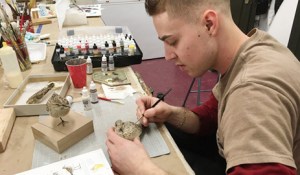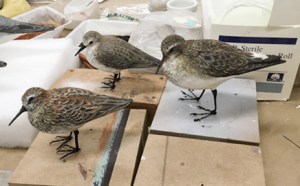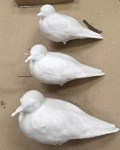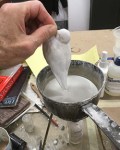
Mike Cummings is a communications officer at Yale University. He previously worked as a reporter for daily newspapers in Mississippi and Connecticut. This article was originally published on YaleNews, April 7, 2017. Republished with permission.
Four sandpipers congregate on a workbench in the basement of Yale’s Peabody Museum of Natural History.
At first glance, the shorebirds look genuine — not unlike the hundreds of taxidermy specimens that populate in the Peabody’s Birds of Connecticut exhibit hall — but these sandpipers never hatched from eggs. They emerged, not quite fully formed, from a 3D printer.
Peabody preparators are using 3D scanning and printing technology to fill gaps in the bird hall’s display. They received an HP Sprout workstation through a grant from Blended Reality, a partnership between Yale and HP to provide faculty, students, and staff access to 3D design, augmented reality, digital imaging, and 3D printing/fabrication technologies.
Michael Anderson, the Peabody’s preparator, said the technology allows his team to produce scientifically accurate models in a quarter of the time it takes to create a model from scratch.
“The work station has made a huge difference,” he said.

The missing species are rare, endangered, or even extinct, making it extremely difficult to create taxidermy mounts of them.
“I think I found three birds over 28 years that we could use for taxidermy mounts,” Anderson said. “Many of these birds are so rare that you would never want to shoot one,” as was the habit years ago.
Even when presented with the opportunity to add a taxidermy mount, Anderson was concerned that his taxidermy skills did not quite measure up to those of his predecessor, the late David Parsons, an expert taxidermist who created most of the mounts on display.
“Dave Parsons was a magnificent taxidermist,” he said. “I would do my absolute best and then hang my head when I compared my work to his.”
About two years ago, Anderson began making models to plug the holes in the bird hall. His first efforts were carved out of wood, which proved too unforgiving.
“Wood is subtractive, and you can’t make mistakes with it,” said Anderson, who sculpted the large Torosaurus statue on the museum’s grounds and maintains a blog about his work at the Peabody.

He tried carving the models from wax, which is more forgiving but still requires a complicated process that involves casting from multiple molds to produce an accurate model.
Anderson considered whether 3D technology could streamline the model-making process. He previously worked with Yale’s Digital Media Center for the Arts to explore using 3D technology to produce leaves for the museum’s dioramas.
“I thought: Let’s scan a taxidermy mount and see what happens,” he said.
Anderson applied for, and received, the grant from Blended Reality, and the workstation arrived in January.
Collin Moret, an artist who works with Anderson, operates the scanning software. Their proposal called for scanning an existing taxidermy mount — a Baird’s sandpiper with breeding plumage — and using it as the basis to create a Baird’s specimen with non-breeding plumage as well four models of different species of sandpiper: a semipalmated sandpiper, a western sandpiper (juvenile), and two white-rumped sandpipers (juvenile and non-breeding plumage).
(Species are represented in the bird hall by one or more specimens showing different sexes, ages, plumage, etc.)
The scan of the Baird’s sandpiper was sized and manipulated for each new model. The 3D printer produces a plastic sculpture with scientifically accurate proportions. (The wing chord and length from wing to tail are key measurements.) The plastic sculpture also shows the feather groupings, which are difficult to delineate accurately when carving from scratch, Anderson said.
The 3D printing leaves rough contours on the sculptures’ surface, making them unsuitable for display. They were dipped into hot wax to conceal the contours. Anderson then carved the feather patterns into the thin wax coating.


The sandpiper models received glass eyes. Beaks were cast in epoxy from a display mount or a “study skin” — a basic taxidermy mount suitable for research but not display. (The Peabody boasts one of North America’s most comprehensive collections of bird specimens.) The models received brass legs from Maishe Dickman, a museum technician who is handy with a soldering iron.
Moret painted the models, consulting study skins to ensure the colors and patterns were accurate. An ornithologist reviews the models before they go on display.
After the sandpipers were finished, Anderson set to work on a female Merlin falcon. (There are about two dozen bird specimens to add to the hall.) Lacking a taxidermy specimen, he sculpted a model from clay. The clay model was scanned and plastic sculpture emerged from the 3D printer. Once completed, the merlin model will assume its perch in the bird hall beside Parsons’ taxidermy specimen of a male merlin.








Comments